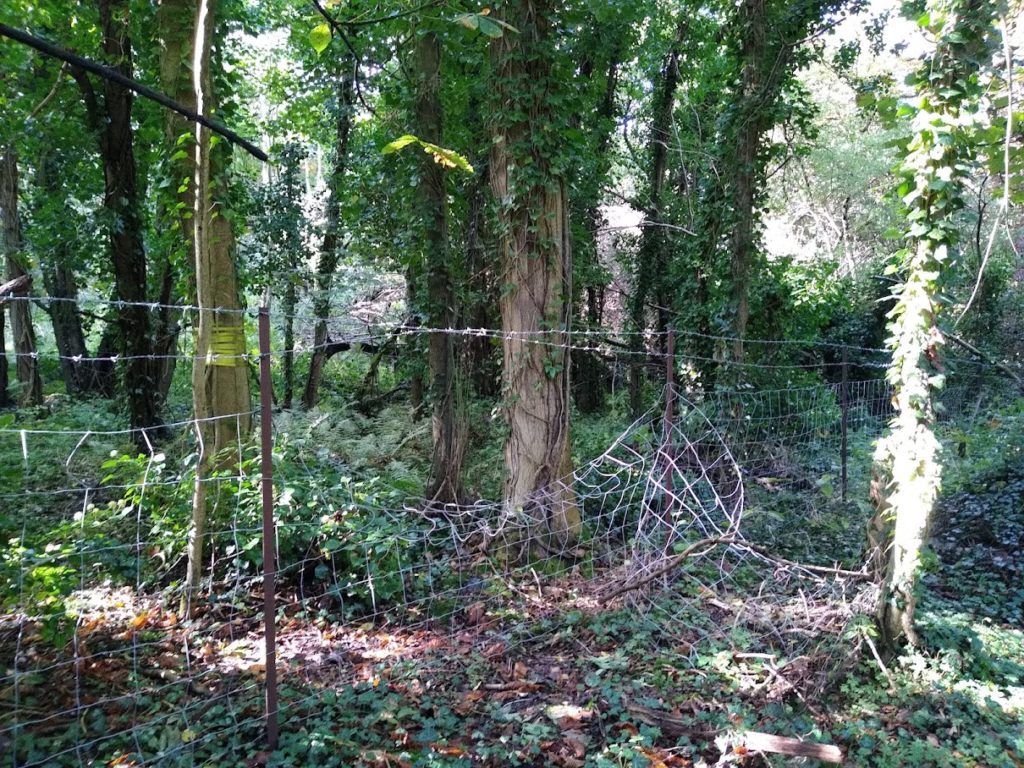In the middle of the journey of our life
I found myself astray in a dark wood*
Beyond the northern edge of the derelict Royal Pioneer Corps camp we visited in Part 1, the way through the wood is blocked off by a 2m high barbed wire fence. The fence runs the full width of the wood, though it has clearly been breached at one point, as shown in the second picture below. But nothing is visible through the wire, other than more trees and undergrowth. What can possibly lie on the other side of it?
 The answer, I later discovered, was that this whole wood, and much of the land surrounding it, once belonged to a country estate centred on a large manor house known as Horsley Hall. Beyond the barbed wire, further into the wood, is the remains of this hall. It was demolished in 1963 and the site is no longer accessible to the public.
The answer, I later discovered, was that this whole wood, and much of the land surrounding it, once belonged to a country estate centred on a large manor house known as Horsley Hall. Beyond the barbed wire, further into the wood, is the remains of this hall. It was demolished in 1963 and the site is no longer accessible to the public.
The first house was built on this site by a local landowner, Dafydd Hen, in the early fifteenth century. The house and estate remained in the same family for many years, though they adopted the modern surname Powell. In 1540 Thomas Powell rebuilt the house creating a substantial wooden structure surrounded by a moat. By the eighteenth century, however, the hall had passed out of the hands of the Powell family to new owners. In 1875, Frederick Potts, now the squire of Horsley Hall, demolished the timber building and replaced it with one constructed from stone.
 Potts lived in the hall until his death in 1898 after which it was bought by an Alfred Ashworth. Ashworth enlarged the hall and remodelled it in the Jacobethan style. He also had a formal garden laid out by the architect George Herbert Kitchin. The property was put up for auction again in 1933, by which time it was a substantial property with 20 main bedrooms, servants’ quarters, formal gardens and even its own golf course.
Potts lived in the hall until his death in 1898 after which it was bought by an Alfred Ashworth. Ashworth enlarged the hall and remodelled it in the Jacobethan style. He also had a formal garden laid out by the architect George Herbert Kitchin. The property was put up for auction again in 1933, by which time it was a substantial property with 20 main bedrooms, servants’ quarters, formal gardens and even its own golf course.
By 1934, however, the prohibitive cost of maintaining the hall convinced its trustees that it should be demolished. But the building was reprieved by the onset of WW2 and the house and estate were requisitioned by the War Ministry for use by the army. When the military finally left in 1958 Horsley Hall was used for a time as a private school. By 1963, however, the school had closed and the hall was demolished.
Very little remains of the hall itself. However, in the Edwardian formal gardens, which are now considerably overgrown, stand a dovecote and gazebo which are listed and maintained by Cadw, the Welsh Government’s historic environment service. Sadly, it is not possible for members of the public to visit the remains of the hall and the formal gardens, hence the barbed wire I encountered on my walk through the woods.
However, three women from a group known as Sisterhood Paranormal Wales managed to get access to the site in December 2014 and some pictures from their Facebook page are shown below.






Very little of the hall remains standing at ground level and above. However, many of the basement rooms remain intact. Even from just the pictures, the eerie atmosphere of these remaining rooms is evident. But, sadly, little of the one-time grandeur of Horsley Hall can still be discerned.
References
* From Dante’s Inferno Canto 1, Translated by Seamus Heaney, 1993
https://www.secret-bases.co.uk/
https://coflein.gov.uk/en/site/27368/
Lowe, Raymond: Lost Houses In and Around Wrexham ( Landmark Publishing, Ashbourne, 2002)




What a shame – what a beautiful building it was. There are Edwardian garden remains in the grounds of Joseph Chamberlain’s house Highbury Hall near to me – they are now part of Highbury Park and it’s moving to encounter them (the Hall is still there and flourishing) and more in Moseley Bog, too.
It was beautiful. There are more pictures on some of the links I’ve given. Apparently, the gardens were even more spectacular. They are currently looked after by Cadw; it would be lovely to see them restored and open to the public. Then again, we’d lose the abandoned eeriness of the site and the adjoining woods!